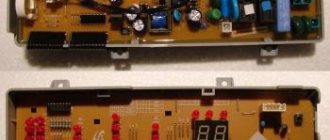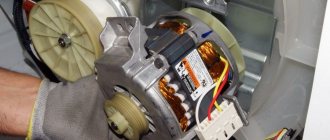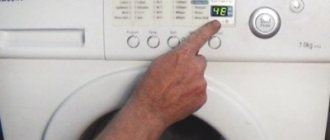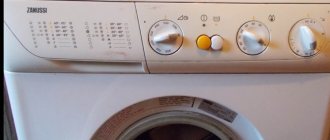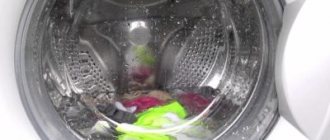You are once again getting ready to wash your dirty clothes: you plugged in the machine, threw the laundry into the drum, poured in the powder and, having selected the desired program, started the wash. Everything seems to be as usual! And suddenly you notice that the washing machine is somehow slowly drawing water, and the wash takes an unusually long time. The first thing I would like to recommend to you is do not panic, this does not mean that the washing machine is broken, perhaps you will be able to fix everything on your own.
In this article, we will look at the main situations in which a washing machine can take a long time to fill with water, and also consider the main breakdowns and how to fix them.
Why is the water supply slow?
This question cannot be answered unambiguously, since the malfunction is influenced by several factors:
- Insufficient water pressure. Machines from any manufacturer (Samsung, LG or Indesit) do not draw water well if there are interruptions in the water supply line.
- The filter is clogged. A common reason why a Samsung washing machine does not draw water well is a clogged filter mesh in the inlet valve.
- Lack of cold water.
- The faucet that does not supply water well to the washing machine is half closed.
- Module failure. An LG washing machine does not draw water well, often due to a breakdown of the “brain” of the technical device. In this case, only a specialist can handle the repair.
- Damage to the water level sensor.
- Heating element malfunction.
Solenoid valve for water
Water level sensor
A pressure switch is a compact round plastic part to which two contacts and a hollow tube are connected. As the washing drum fills with water, the air pressure in the tube and chamber of the device increases. It changes depending on the amount of water in the drum. The mechanism of operation of the part is that after a certain programmed water level has reached a certain level in the tank, the pressure increases, which is a signal for the relay to operate - closing or opening its contacts. The operation of the sensor depends on the settings (the selected washing mode, which requires less or more water). The information is sent to the washing machine computer and it turns off the water supply.
Why might water not be collected at all?
Washing machines Indesit, Samsung or LG may not only draw water poorly, but may not collect water at all for washing. What is the reason?
- The tap that supplies water to the drum is completely closed.
- Lack of water.
- The door is not closed properly, the lock is faulty.
- The pressure switch is broken.
- The valve supplying liquid to the washing machine is broken.
- Device connection is incorrect.
- Violation of operating rules.
Water supply to the drum
Features of washing machine problems
In most cases, the washing machine does not draw water and does not spin the drum. This can happen if any of the above problems occur, and further operation of the unit is suspended. Modern cars are equipped with an automatic diagnostic system, which in this case displays a corresponding signal on the display in the form of an error code. By deciphering this code given in the instructions, you can determine the problem that has arisen and the possible malfunction of a particular unit.
In some cases, the washing machine does not draw water, but spins the drum. This happens due to failures in the automation system, when the electronic brain of the machine believes that the drum is full and continues the specified washing mode. First of all, this problem appears when a malfunction occurs in the electronic control unit. Sometimes the cause may be a failure of the liquid level sensor, which in itself is considered a fairly reliable device.
How can I improve the situation?
Before calling a workshop or attempting to repair the device yourself, you need to perform basic steps to find the exact cause of the washing machine malfunction and how to fix it. The first thing to check is how tightly the hatch is closed and whether the lock works. If the door is not closed properly, the machine does not turn on automatically - this is how it is protected from unforeseen circumstances, for example, from a flood.
Water supply hose
If the hatch is fine, the problem may be the water pressure on the line. Call the utility company and find out what the problem is and how soon it will be resolved. Slow water pressure in this case will not harm the operation of the washing machine, but the washing process itself will be delayed.
Also, sometimes the tap supplying water to the washing machine is faulty, or it is not fully open.
Possible causes and solutions
No flow or low pressure from the water supply
When you open the taps of the water supply system, water does not flow or flows weakly
Turn off the machine and wait for the problems in the plumbing system to be resolved
Clogged inlet hose or inlet strainer
Disconnect the supply hose and filter, inspect them and blow them out
Clean the hose and filter from debris and rinse under running water.
The side door is not closed tightly, the lock does not work
Check the tightness of the door, the condition of the locking mechanism and the fastening of the door hinges
Press the door firmly until the lock clicks. If necessary, clean the latching mechanism and tighten the hinges
Damage to connecting wires or their insulation, oxidation of contacts
Inspect and test the internal electrical wiring with a tester for open circuits and short circuits.
Restore the integrity of electrical wires and their insulation, clean contacts
The inlet (fill) valve does not work
Check the operation of the valve when 220V is applied to it. Inspect and test the valve windings, electrical wires and contacts with a tester
Restore the connecting wires, clean the contacts. Replace the faulty valve.
The electric door lock is faulty
Test the blocker winding with a tester for open circuit and short circuit. Check the status of contacts
Clean contacts. Replace the faulty lock.
The level sensor (pressure switch) is faulty
Check if the sensor receiving tube is clogged.
Test the sensor and connecting wires with a tester for opens and short circuits.
Clear the sensor receiving tube of any accumulated debris.
Replace faulty sensor.
The software control module is faulty
The module does not receive control signals to trigger the machine components when they are working properly
Use a tester to check the receipt of control signals to individual nodes. Repair the module in a workshop or replace it with a working one.
Most of these problems can be fixed on your own, but in some cases you cannot do without contacting a service workshop.
If you decide to carry out the repairs yourself, we offer the best range of spare parts for washing machines.
DIY repair
Depending on the problem, repairs may vary. Some problems can be fixed with your own hands, while others can only be dealt with by professionals. DIY repair methods:
- If there is water on the line, but the pressure is very weak, you can simply continue washing, but regardless of the program, the washing process will take a little longer. If this option does not suit you, then you need to call the utility company and find out why the dialing has been reduced and the time frame for restoring problems on the line.
- The water supply to the washing machine can be turned off using a special tap. If it is not fully open, water will be drawn in, but very slowly. The fix is easy. If the valve is open completely, but it is clear that this is the reason, the valve itself may break down, then it will have to be replaced.
- Sometimes water does not flow well into the washing machine because the inlet hose is kinked. It is necessary to check for this problem and straighten the hose.
- At the entrance to the washing machine, where the valve is installed, there is a special filter. At times it becomes clogged, and then the liquid flows into the washing machine is weak. If you clean it, the problem will disappear.
Troubleshooting yourself:
The situation in which the “washing machine” slowly draws water can be twofold. The reasons may be a breakdown, an unfortunate combination of circumstances or simple carelessness.
So, the main situations in which you can solve the problem yourself:
- The water supply has low water pressure. You can check the pressure visually by opening the cold water tap all the way. If the water barely flows from the tap, rejoice, the problem has been found.
In this case, there are only 2 options:
- continue washing, not paying attention to the low pressure, but you should be patient, because the machine will take a long time to wash;
- wait until the water pressure in the tap becomes normal. During this time, you can dial the telephone number of utility services and reliably find out about the causes of low pressure and the time to fix the problem.
Electronics problem
Shut-off valve is not fully open. With the help of such a valve, the water supply to the washing machine is closed or opened. If a valve is detected that is not completely open, the problem can be solved with one movement of the hand - simply open the valve all the way. It may happen that the crane itself has suffered physical wear and tear. The faucet may stall or begin to rotate. In such a situation, you must independently replace the old faucet with a new one or call a plumber.- There is a kink in the inlet hose. When you have checked the water pressure and found no problems, you need to inspect the supply hose; a kink may form: it is likely that the reason for the poor flow of water into the “washing machine” was a kink in the hose. It's easy to fix the problem - just straighten the hose and the water flow will resume.
- The fill valve strainer, which is installed at the inlet of the washing machine, is clogged. In the place where the inlet hose is connected to the washing machine, a filter mesh is installed, which allows all the water entering the washing machine to pass through it. Over time, the filter may become clogged and have poor water flow, since tap water contains various impurities and small particles. You can fix this like this:
- shut off the water supply;
- unscrew the inlet hose;
- Using pliers, very carefully pull the mesh out of the inlet valve;
- then clean it with a stiff brush and rinse under strong water pressure.
In the case where the above tips did not bring the expected success, and your washing machine still slowly draws water, then the most likely reason may be a breakdown.
The filter mesh is clogged
A common factor that influences the machine not drawing water or doing it very slowly is a clogged filter mesh. It is located in front of the inlet valve and is designed to protect the unit from small debris that may enter from the water supply. But, since the quality of water often leaves much to be desired, this mesh can become clogged and prevent liquid from passing through. Or the pressure will become very weak.
What to do?
You can call a technician to clean the filter mesh, or you can try to deal with the problem yourself. To do this, you need to turn off the valve and disconnect the hose at the place where it connects to the washing machine. Then clean the mesh from any accumulated dirt and rust. After this, rinse the hose itself under high pressure.
Water supply hose problem
If this does not help, check the hose to see if it is broken or if there is something heavy on it that could impede the flow of fluid. Another factor affecting the set is a clogged hose. In this case, liquid can flow into the unit, but very slowly and with little pressure.
What to do?
If there is anything on the hose, remove it. It may be damaged, then you will have to replace it with a new one. If clogged, you need to disconnect it from your unit and rinse it well under strong pressure.
Failure of the water supply valve
The intake valve is activated when it receives a signal from the control module. But in some cases the valve breaks; there may be several factors for this: a clogged filter, or a burnt-out winding coil. Then the machine completely stops drawing liquid. To find out if the valve is the cause of this, you need to remove it and connect it to the inlet hose. Then apply current to each coil and check the valve: if it opens, then this is not the problem, it is working properly. If it doesn’t open, then it’s out of order. Another option is that the valve opens and closes after turning off the power, but it is not tight enough, and you will see that liquid continues to leak. This occurs due to weakening of the elasticity of the diaphragm or rod springs.
Problem with the pressure switch
The pressure switch, also known as a water level sensor, is responsible for the amount of liquid collected in the tank. If the pressure switch is broken and does not evaluate, then it does not arrive and the washing machine does not start the wash cycle. To make sure that the sensor is broken, you need to check it. To do this, you need to remove it, and then disconnect the hose and contacts. After this, it is advisable to clean the contacts and rinse the hose.
Now check the sensor: take a second hose of the same diameter as the one you disconnected. Attach it to the inlet fitting and blow into it. At this time, place the pressure switch to your ear and listen: the presence of clicks will indicate the serviceability of the sensor, their absence will indicate a breakdown.
What to do?
If the problem is in the pressure switch, then it needs to be replaced. To do this, you need to call a technician or contact a service center.
Heating element malfunction
If the heating element responsible for heating the water breaks down, the washing machine stops drawing water, and many other functions stop working. In this case, the rinse mode should work, because it does not require heating. If the problem really is a breakdown of the heating element, then you will notice this by other signs: after washing, the laundry remains dirty and has an unpleasant odor, the door remains cold.
What to do?
To solve the problem, you need to replace the heating element.
Control module problem
The most difficult problem, which is unlikely to be solved on your own unless you have special skills and knowledge, is a breakdown of the control module. It is from there that commands come, including to the intake valve. Contacts in any section of the module may burn out. Reasons for this phenomenon:
- ingress of liquid or detergents into the contact system;
- short circuit in external networks;
- too much load on the contacts of the heating elements.
If this failure occurs, the control module will most likely need to be replaced.
What to do?
The easiest way is to entrust the repair to professionals. In the meantime, remember the old way of washing - by hand. If you are not going to give up, then you can try cleaning the contacts of the control module. To do this, you will need a special liquid that needs to be injected into the section where there are burnt contacts. If the deposit is small, then this simple action can be quite effective.
Why is my washing machine not drawing water well?
There is also a situation when the washing machine takes in water, but slowly and in insufficient quantities . Why does this happen and what to do in such a situation? There can be many reasons for this, and they are the same ones because of which she does not gain anything at all. Here is a short list of them:
- Weak pressure in the tap. If this is true, then the machine will not type well. Then just wait until the situation changes and you can wash as usual. Or you will have to come to terms with the fact that the washing process will take a long time.
- The valve is not fully open. Check it and correct it if necessary.
- The filter mesh is clogged. This reason and the way to eliminate it were described above. But even if the machine generates weak pressure, it is better to eliminate this malfunction as quickly as possible. Otherwise, the filter will become completely clogged and the washing machine will stop working altogether.
- Problems with the hose - it may be broken, crushed by a heavy object, or clogged.
- Intake valve malfunction. It may need to be replaced.
If you find that your washing machine does not fill with water or does not fill well, follow this algorithm of actions.
Washing machine inlet valve
The inlet valve of a washing machine can be single, double or triple. Accordingly, some modes are capable of collecting water, while others will not. Each path must be checked separately. To do this, the washing machine is disassembled. The top cover is often removed first. Nothing else is needed - the inlet valve is located at the top of the rear wall.
Inside there are coils according to the number of channels, each with a core that opens and cuts off the flow of water. At the common input there is a pressure reducer. It's just a rubber washer; you can remove it and wash it if you can see that dirt has accumulated inside. Be careful! If dirt becomes clogged in the inner membrane, the valve will begin to constantly poison the water. In the latter case, it is extremely difficult to repair the part. You'll have to buy a new one.
Now for the device. Each coil includes a core-rod resting on a membrane, in the center of which a hole is made. In normal condition, the return spring keeps the system closed. When current is applied to the coil, the rod rises, allowing water to flow freely. This is how sampling is done for any step of the cycle. A voltage of 220 V is supplied to the coils; by disconnecting the terminals, each stroke can be checked.
Attention! Take precautions when working with high voltage.
Why is the washing machine taking on water slowly?
It is quite easy to discover that the washing machine takes a long time to fill with water - quite a long time passes, and the wash still does not start. In this case, you will have to check everything, from external elements to the internal parts of the device. If the washing machine slowly draws water immediately after connection and installation, you should check the water supply. The pressure may not be strong enough and therefore filling the device to the required level may take a long time. You should also check the faucet in case it is not open enough or is broken.
If this is not the problem, then the malfunction may occur for the following reasons:
- the inlet filter is clogged;
- the intake valve has broken down;
- the water level sensor has failed;
- the programmer is broken;
Possible faults
You checked the external causes and cleaned the filter, but you couldn’t understand why the washing machine takes so long to fill with water. This means the reason is in the washing machine itself, and here you need a technician to inspect the equipment.
Faulty water supply valve - from RUB 1,400*
The mechanism for closing the membrane in the valve may fail, and it does not move as expected. Filling occurs slowly through the narrow gap. This breakdown is usually typical for older cars. In this case, you need to change the valve completely.
The pressure switch has failed - from 1500 rubles*
Filling the tank depends on the readings of the water level sensor. When the control module receives an incorrect overflow signal or does not receive data, the machine stops drawing water. The technician will inspect the pressure switch and tell you what is required, repair or replacement.
The control module is broken - from 1800 rubles*
In this case, the washing machine may take a long time to draw water or stop completely, not responding to turning off and changing the program. Failure of the module leads to loss of communication with the filling valve or to a complete interruption of commands.
The technician will determine the degree of damage to the unit during diagnostics. Repair is possible when the board tracks are damaged or some radio components are burned out, for example, capacitors, resistors or diodes. If the microcircuit is severely damaged, it cannot be repaired; the module will need to be replaced.
*Spare parts are not included in the price and must be paid separately.
Have you noticed that the machine takes in water too thoughtfully? Call Wash Man! Repair within 24 hours after request, warranty on work and spare parts for 2 years.
We wish your equipment health!
How to troubleshoot a problem
If the washing machine slowly draws water, then you should start checking with the inlet filter. First, you should remove it and inspect it for rust or plaque. After this, you just need to carefully rinse the filter under running water from the sink, removing all existing blockages. If it was the problem, then after installing it back, water will flow at normal speed.
The next check point will be the valves. Here the problems can be much more diverse, and it will take time to check them. Often the cause of slow water intake is the mesh on the valves, which becomes clogged over time, or a burnt-out winding. If a blockage occurs, it can be simply removed by cleaning the mesh. Regular annual cleaning of the screens in all valves will help avoid this problem. And a burnt-out winding can be replaced with the same one from another valve, since they are most often interchangeable.
Another reason why the washing machine is slow to fill with water may be failure of the electronics. Often the water level sensor and programmer break down. They are responsible for the correct execution of the user's program. It is quite difficult to independently check their performance, since they are not only located quite inconveniently for dismantling, but also their inspection requires special knowledge. Attempts to fix such a malfunction yourself may cause new breakdowns due to negligence. If there is a suspicion that the electronics in the washing machine have broken down, it would be safer to turn to specialists for help.
No water supply
If the washing machine does not fill with water, this can also be explained by many circumstances.
for supplying water to the machine is closed The fluid supply valve must be checked first. It is usually located where the rubber hose from the machine is connected to the pipeline. If the tap is open, then the lever is located in accordance with the movement of the liquid, that is, along the hose.
There is no water or its pressure is too weak.
Unfortunately, this happens quite often; to eliminate this cause, you just need to open any water tap. If this is the reason that the machine does not take in water, then in any case you will have to wait until it appears. laundry hatch
door As a rule, modern washing machines have many degrees of protection, one of which is that if the hatch door is open or not tightly closed, the machine will not draw water and, accordingly, washing will not start. That is, to eliminate this problem, you need to try to close the door tightly. If the door does not lock by hand, then most likely the latch or locking tab located in the housing lock is broken. It is possible that the tongue is simply skewed; this happens when the rod that serves as a fastener falls out. Over time, the hinges on the door weaken and the hatch becomes warped. That is, if the reason lies in the door, then it will need to be removed in order to put the rod in place. If the lock itself is broken, it will need to be replaced.
How and with what you can remove paint from clothes
Another reason could be a broken door lock . Any modern machine is equipped with a special locking function that turns on just before washing for the safety of the user. If this function is not turned on, the washing process does not start and, therefore, water does not enter the machine.
inlet valve is broken. The inlet valve is a part that is responsible for the timely supply of water. The incoming signal opens the valve, and water flows freely into the machine. When a signal is received indicating that there is enough water, the valve closes and the flow of water is blocked. That is, if the valve is broken, it does not open, which means water cannot be drawn in. Most often, the coil burns out in such valves. In order to determine this, you need to ring the valve. It is located at the back of the washing machine and has an inlet hose attached to it. If the failure lies in the valve described above, it will need to be replaced.
Pump malfunction . To solve this problem, you will have to contact a specialist, since replacing the pump is quite complicated.
The software module is broken . The software module is a kind of computer center of the washing machine, responsible for performing all intellectual tasks. It contains information about programs, washing times and the operation of all sensors.
A programmer breakdown is a serious problem, and it will not be possible to solve it without calling a specialist. If this important part cannot be repaired, it will need to be replaced. But before calling a technician, you should still check all the details described above, because in ninety-nine percent of cases the breakdown is associated with the filter or door.
How to wash a winter parka in a washing machine
